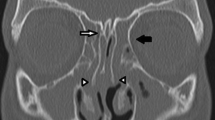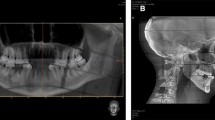Abstract
More than 10 years ago, cone-beam-computed tomography (CBCT) was introduced in ENT radiology. Until now, the focus of research was to evaluate clinical limits of this technique. The aim of this work is the evaluation of specific dosages and the identification of potential optimization in the performance of CBCT of the paranasal sinuses. Based on different tube parameters (tube current, tube voltage, and rotation angles), images of the nose and the paranasal sinuses were taken on a phantom head with the Accu-I-tomo F17 (Morita, Kyoto, Japan). The dosages applied to the lens and parotid gland were measured with OSL dosimetry. The imaging quality was evaluated by independent observers. All datasets were reviewed according to a checklist of surgically important anatomic structures. Even for lowest radiation exposure (4 mA, 76 kV, 180°, computed tomography dosage index (CTDI) = 1.8 mGy), the imaging quality was sufficient. Of course a significant reduction of the imaging quality could be seen, so a reliable mean was set for 4 mA, 84 kV, and 180° rotation angle (CTDI = 2.4 mGy). In this combination, a reduction of 92 % in lens-dose and of 77 % of dosage at the parotid gland was observed in comparison to the maximal possible adjustments (8 mA, 90 kV, 360°, CTDI = 10.9 mGy). There is potential for optimization in CBCT. Changing the rotation angle (180° instead of 360°) leads to a dose reduction of 50 %. Furthermore from clinical point of view in case of chronic rhinosinusitis a relevant reduction of dosage is possible. Therefore, it is necessary to intensify the interdisciplinary discussion about the disease specifics required quality of imaging.






Similar content being viewed by others
References
Stuck BA, C. Bachert P. Federspil et al. (2011) Rhinosinusitis guidelines-unabridged version: S2 guidelines from the German Society of Otorhinolaryngology, Head and Neck Surgery. HNO
Bremke M, R. Leppek and J.A. Werner (2010) Digital volume tomography in ENT medicine. HNO
Güldner C, Diogo I, Windfuhr J et al (2011) Analysis of the fossa olfactoria using cone beam tomography (CBT). Acta Otolaryngol 131(1):72–78
Kurzweg T, Dalchow CV, Bremke M et al (2011) The value of digital volume tomography in assessing the position of cochlear implant arrays in temporal bone specimens. Ear Hear 31(3):413–419
Savvateeva DM, Güldner C, Murthum T et al (2010) Digital volume tomography (DVT) measurements of the olfactory cleft and olfactory fossa. Acta Otolaryngol 130(3):398–404
Offergeld C, Kromeier J, Aschendorff A et al (2007) Rotational tomography of the normal and reconstructed middle ear in temporal bones: an experimental study. Eur Arch Otorhinolaryngol 264(4):345–351
Kyriakou Y, Kolditz D, Langner O, Krause J, Kalender W (2011) Digital volume tomography (DVT) and multislice spiral CT (MSCT): an objective examination of dose and image quality. Rofo 183:144–153
Yukihara EG, McKeever SW (2008) Optically stimulated luminescence (OSL) dosimetry in medicine. Phys Med Biol 53(20):R351–R379
Al-Senan RM, Hatab MR (2011) Characteristics of an OSLD in the diagnostic energy range. Med Phys 38(7):4396–4405
Damet J, Sans-Merce M, Mieville F et al (2010) Comparison of organ doses and image quality between CT and flat panel XperCT scans in wrist and inner ear examinations. Radiat Prot Dosimetry 139(1–3):164–168
Zuckerkandl E (1882) Normale und pathologische Anatomie der Nasenhöhle und ihrer pneumatischen Anhänge. In: W. Braumüller (ed) vol. 1. Vienna
Keros P (1962) On the practical value of differences in the level of the lamina cribrosa of the ethmoid. Z Laryngol Rhinol Otol 41:809–813
Kainz J, Stammberger H (1988) The roof of the anterior ethmoid: a locus minoris resistentiae in the skull base. Laryngol Rhinol Otol (Stuttg) 67(4):142–149
Ohnishi T, Yanagisawa E (1994) Endoscopic anatomy of the anterior ethmoidal artery. Ear Nose Throat J 73(9):634–636
Simmen D, Raghavan U, Briner HR et al (2006) The surgeon’s view of the anterior ethmoid artery. Clin Otolaryngol 31(3):187–191
Bremke M, Wiegand S, Sesterhenn AM et al (2007) Digital volume tomography in the diagnosis of nasal bone fractures. Rhinology 47(2):126–131
Bremke M, Sesterhenn AM, Murthum T et al (2009) Digital volume tomography (DVT) as a diagnostic modality of the anterior skull base. Acta Otolaryngol 129(10):1106–1114
Balbach L, Trinkel V, Guldner C et al (2011) Radiological examinations of the anatomy of the inferior turbinate using digital volume tomography (DVT). Rhinology 49(2):248–252
ICRP (2007) The 2007 Recommendations of the International Commission on Radiological Protection. ICRP publication 103. Ann ICRP 37(2–4):1–332
Prins R, Dauer LT, Colosi DC et al (2011) Significant reduction in dental cone beam computed tomography (CBCT) eye dose through the use of leaded glasses. Oral Surg Oral Med Oral Pathol Oral Radiol Endod 112(4):502–507
Conflict of interest
None.
Author information
Authors and Affiliations
Corresponding author
Rights and permissions
About this article
Cite this article
Güldner, C., Ningo, A., Voigt, J. et al. Potential of dosage reduction in cone-beam-computed tomography (CBCT) for radiological diagnostics of the paranasal sinuses. Eur Arch Otorhinolaryngol 270, 1307–1315 (2013). https://doi.org/10.1007/s00405-012-2177-2
Received:
Accepted:
Published:
Issue Date:
DOI: https://doi.org/10.1007/s00405-012-2177-2




